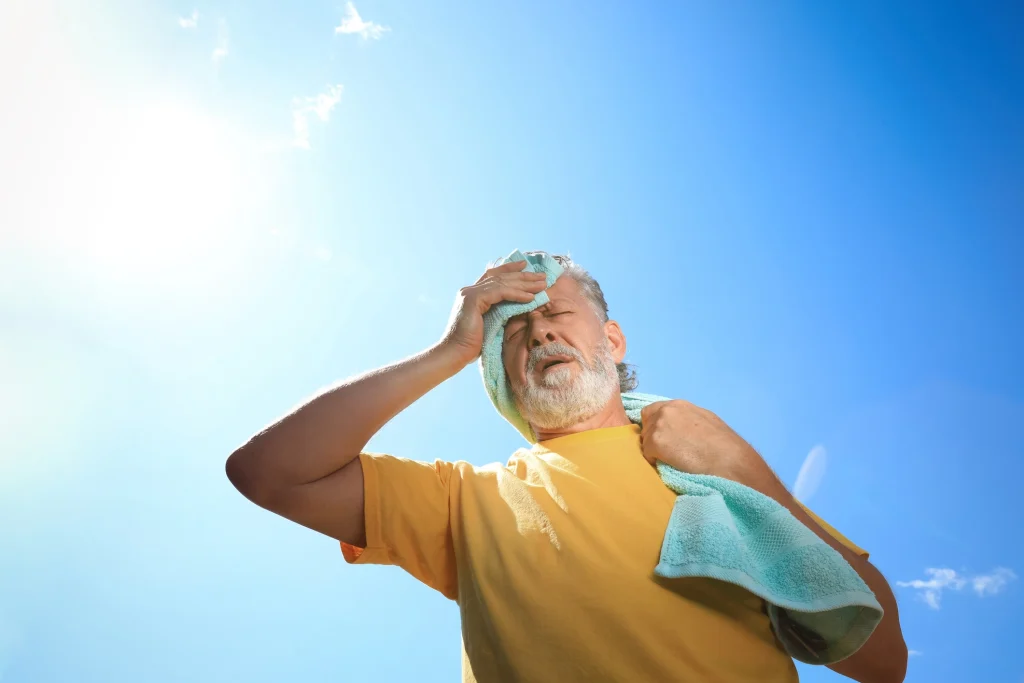
Initiatives to protect people from extreme heat waves
Protecting Americans from Extreme Heat
Summary: As extreme heat events become more frequent and intense due to climate change, it’s crucial to understand how to protect ourselves and our loved ones from heat-related illnesses. The Centers for Disease Control and Prevention (CDC) offers comprehensive guidelines to mitigate the risks associated with heat waves. This article explores the key recommendations provided by the CDC and why it’s essential for everyone to be informed about preventing heat-related illnesses
1. Understanding Extreme Heat
- Extreme heat refers to unusually high temperatures that surpass typical seasonal averages for a particular region. These conditions can vary depending on geographic location and climate patterns. In regions with high humidity, extreme heat can feel more oppressive due to reduced evaporation of sweat, making it harder for the body to cool down.
- Extreme heat can pose serious health risks, leading to heat-related illnesses such as heat exhaustion and heat stroke. It’s important to stay hydrated, seek shade or air-conditioned spaces, and avoid strenuous activities during periods of extreme heat to prevent adverse health effects. Additionally, vulnerable populations such as the elderly, children, and individuals with chronic illnesses are at higher risk during heat waves and should take extra precautions to stay safe.
- It can have detrimental effects on health, increasing the risk of heat-related illnesses such as heat exhaustion and heat stroke. Prolonged exposure to high temperatures can lead to dehydration, heat cramps, and heat exhaustion, which if left untreated, can progress to life-threatening heat stroke. Additionally, extreme heat can exacerbate existing health conditions like respiratory and cardiovascular diseases. Vulnerable populations, including the elderly, children, pregnant women, and individuals with chronic illnesses, are particularly at risk.
- To mitigate these impacts, it’s crucial to stay hydrated, seek shade or air-conditioned environments, and avoid strenuous outdoor activities during peak heat hours. Moreover, understanding the signs of heat-related illnesses and taking preventive measures can help safeguard against the adverse health effects of extreme heat.
2. Identifying Heat-Related Illnesses
- Heat exhaustion symptoms include heavy sweating, weakness, dizziness, headache, nausea, and fainting. Rapid pulse, cool, moist skin, and muscle cramps are common indicators. Identifying these signs promptly is crucial for timely intervention. Stay hydrated, avoid excessive heat exposure, and seek shade when outdoors. If symptoms persist or worsen, seek medical assistance immediately. Understanding heat exhaustion signs aids in prevention and ensures swift action for recovery. Learn to recognize these symptoms to safeguard against heat-related illnesses and maintain overall well-being in hot climates or during strenuous activities.
- Heat exhaustion progresses to heat stroke when the body’s core temperature rises above 104°F (40°C). Symptoms of heat exhaustion, like heavy sweating, nausea, and weakness, intensify in heat stroke. Without prompt treatment, heat stroke can lead to organ damage, seizures, or even death. It’s crucial to recognize warning signs and take immediate action by moving to a cooler place, hydrating, and seeking medical help. Understanding these distinctions and acting swiftly can prevent severe consequences of heat-related illnesses. Stay informed and prioritize heat safety measures, especially during hot weather or strenuous activities.
- Differentiating between heat exhaustion and heat stroke is crucial for timely treatment. Heat exhaustion symptoms include heavy sweating, weakness, dizziness, and nausea. In contrast, heat stroke symptoms involve high body temperature, confusion, rapid pulse, and possible loss of consciousness. Understanding these distinctions enables prompt intervention. Seek medical attention immediately for suspected heat stroke, as it can be life-threatening. Recognizing these signs promptly ensures appropriate care, reducing the risk of complications from severe heat-related illnesses.
3. Staying Safe in Hot Weather
- Stay hydrated, drink water frequently. Avoid excessive outdoor activities during peak heat hours. Wear lightweight, light-colored clothing and use sunscreen. Seek cool environments like air-conditioned spaces. Never leave children or pets in parked vehicles. Check on vulnerable individuals like the elderly. Stay informed about heat wave alerts and warnings. By adhering to these CDC guidelines, you can mitigate the risks associated with extreme heat and safeguard your well-being.
- Individuals can prepare for extreme heat events by staying hydrated, wearing light-colored, loose-fitting clothing, and seeking shade when outdoors. Additionally, they should avoid strenuous activities during peak heat hours and use sunscreen to protect their skin. Creating a cool environment at home with fans or air conditioning is crucial. Being aware of heat-related illnesses and knowing the signs is essential for prompt action. Planning ahead and staying informed about weather forecasts can help mitigate risks during extreme heat.
4. Protecting Vulnerable Populations
- Pregnant women can safeguard against heat-related illnesses by staying hydrated, wearing loose, light-colored clothing, and avoiding outdoor activities during peak sun hours. Opting for cool showers, staying indoors with air conditioning, and using fans can help regulate body temperature. It’s crucial to prioritize frequent breaks and seek shade when outdoors. Consulting healthcare providers for personalized advice is essential. These measures mitigate the risk of heat exhaustion or heatstroke during pregnancy, ensuring maternal and fetal well-being in hot weather conditions.
- Cooling centers offer vital refuge during heatwaves, safeguarding vulnerable groups like the elderly and homeless from heat-related illnesses. Providing cool environments, hydration, and sometimes medical aid, these centers mitigate health risks during extreme temperatures. By offering relief, they reduce the incidence of heat-related illnesses and fatalities. Additionally, they foster community support and awareness, enhancing public health resilience. Accessible, well-equipped cooling centers are integral to urban planning and emergency preparedness strategies, ensuring the welfare of at-risk populations during heatwaves.
5. Importance of Hydration and Nutrition
- Staying hydrated in hot weather is vital for overall health and well-being. Adequate water intake prevents dehydration, heatstroke, and heat exhaustion. Hydration maintains body temperature, aids digestion, and supports organ function. It also boosts energy levels and enhances cognitive performance. Drinking water regulates electrolyte balance, preventing muscle cramps and promoting cardiovascular health. Optimal hydration keeps skin hydrated, reducing the risk of sunburn and premature aging. Ensure to drink plenty of water to stay healthy and comfortable during hot weather.
- Electrolytes regulate body temperature by balancing fluids and transmitting electrical impulses. Adequate electrolyte levels prevent dehydration and maintain proper hydration, crucial in preventing heat-related illnesses like heat exhaustion and heat stroke. Replenishing electrolytes through hydration and balanced diets is essential for optimal heat resilience and overall health.
- Thing to ensure to maintain proper hydration levels during heat waves.
- Stay hydrated by drinking water frequently.
- Avoid dehydrating beverages like alcohol and caffeine.
- Consume hydrating foods like fruits and vegetables.
- Carry a reusable water bottle for easy access.
- Monitor urine color; pale yellow indicates proper hydration.
- Seek shade and cool environments to prevent overheating.
6. Raising Awareness and Education
- Education campaigns raise heat illness awareness by disseminating crucial information on symptoms, prevention, and treatment, enhancing public understanding and preparedness.
- Healthcare providers educate patients on heat safety through personalized guidance, emphasizing risk factors, hydration, and recognizing warning signs, fostering proactive measures for prevention.
- Collaborative efforts empower communities to prevent heat-related illnesses by sharing resources, organizing workshops, and promoting safety measures like hydration, shade provision, and recognizing early symptoms, ensuring widespread knowledge dissemination and protection.
7. Addressing Environmental Factors
- Poor air quality exacerbates heat-related illnesses by increasing respiratory stress and inflammation, heightening susceptibility to heat stroke and other conditions. It amplifies heat’s impact on vulnerable populations, such as the elderly and those with preexisting health issues.
- To enhance air quality during heat waves, prioritize reducing emissions from vehicles and industrial sources. Implementing stricter regulations on pollutants like particulate matter and ozone is crucial. Encouraging public transport, cycling, and walking can also diminish pollution levels.
- Urban planning significantly influences heat mitigation efforts. Incorporating green spaces, tree canopies, and reflective surfaces in city designs can lower temperatures. Strategically placing buildings to provide shade and employing cool roofing materials are effective tactics. Additionally, promoting energy-efficient infrastructure reduces urban heat island effects, fostering cooler environments.
8. Long-Term Strategies for Heat Resilience
- To build resilience against extreme heat events, local, national, and global measures include urban green spaces, heat-resilient building designs, and early warning systems. Communities can adapt infrastructure by incorporating cool roofs, permeable pavements, and green roofs. Policy changes should prioritize heat adaptation strategies in urban planning and public health initiatives. Collective action is essential in addressing climate change by advocating for renewable energy, sustainable practices, and policy reforms to reduce greenhouse gas emissions and mitigate extreme weather risks.
Conclusion:
As extreme heat events continue to pose significant risks to public health, it’s imperative to heed the guidance provided by organizations like the CDC. By understanding the signs of heat-related illnesses, staying informed about heat alerts, and taking proactive measures to stay safe during heat waves, individuals and communities can protect themselves and prevent unnecessary heat-related deaths and illnesses.
Key Takeaways:
- Stay hydrated and avoid prolonged exposure to extreme heat.
- Recognize the signs of heat exhaustion and seek medical attention if necessary.
- Utilize resources from the CDC and other agencies to prepare for extreme heat events.




